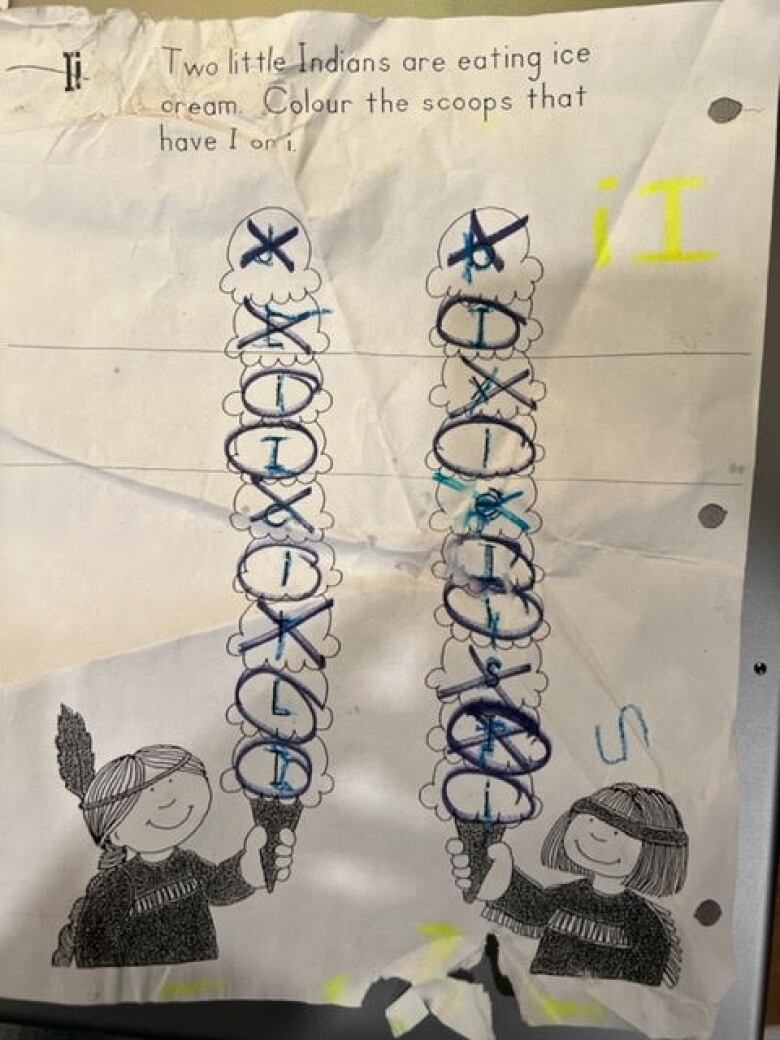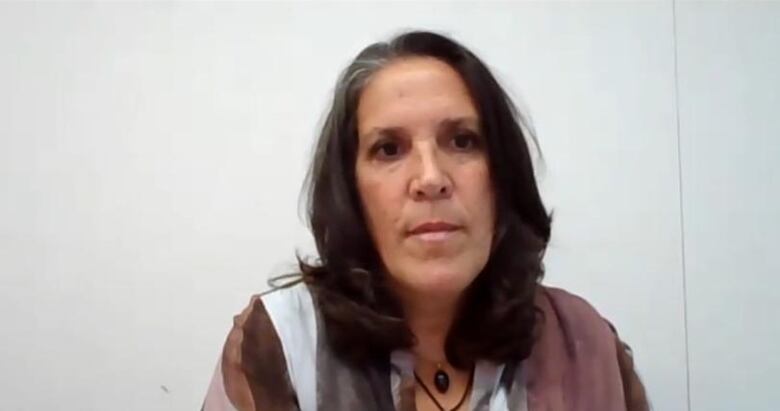Indigenous student sent home with 'offensive' worksheet, prompting audit at Niagara school
Teacher faces 'disciplinary action' for sending home sheet depicting stereotypes

Warning: This story contains theimage in question.
A Niagara-area school isauditing thematerials of a teacher who's facingundisclosed "disciplinary action"after a student was sent homewith a worksheetdepictingtwo cartoon characters in stereotypical Indigenous clothing, including feathered headbands.
Tracee Smith, who lives inNiagara-on-the-Lake, Ont., was shocked when her four-year-old sonEkkian Christmascame home from junior kindergarten with theworksheet entitled "Two little Indians are eating ice cream."It asked students to "colour the scoops that have an 'I' or 'i' on it."
"I couldn't believe that I was reading it. I went from being shocked,to upset, to really disappointed, all very quickly," said Smith,a member of the Missanabie Cree First Nation in northern Ontario.
She said other children in the class also were given the worksheet.

Smith's son started at St. Davids Public Schoolthree weeks ago. She said he was unaware, because of his age,that the worksheetwas offensive, but his older sister, who is in Grade 1, understood it was.
"We still have teachers using this material and not realizing how hurtful it can be," Smith said.
"You'll hear the term 'Indian' used in very racist, hurtful ways from mostly non-Indigenous people, from the past."
St. Davids Public School principal Carl Glauser sent an email to parents after Smith made the school and theDistrict School Board of Niagara (DSBN) aware of the worksheet.
"We are sincerely sorry to the students, familiesand entire school community that this offensive material was distributed," Glauser said in the email.
'You would think we would have gotten past this'
Smith said the worksheet hit close to home,not just because she and her husband are Indigenous, but because Smith also works in Indigenous education.
She is the founder and chief executive officerof Outside Looking In, an educational program that brings Indigenous and non-Indigenous students together to learn about each other, and offers high school credits to Indigenous students through their dance program.
"I work with curriculum, and teachers and principals all the time," Smith said.
"Twenty-fivekids that I know of got that worksheet. You would just think that we would have gotten past this already."
Georgie Groat, the Indigenous education lead for the DSBN, works with a team of seven student achievement leaders for Indigenous education.

She said the worksheet that washanded out in class"shows how much more work we have to do."
In the email sent home to parents, Glauser agreed with Groat.
"We know there is still much more work to be done as we keep with our journey towards truth and reconciliation," Glauser said.
Teacherfacing 'disciplinary action'
Kim Sweeney, the senior manager of communications and public relations for DSBN, said the incident is under investigation.
"The principal started by doing an audit of all the materials for that particular grade," Sweeney said,addingthe audit would go over handouts, materials used in class and materials hanging on the walls in the classroom.

She said the school board believes no one outside of Ekkian's teacher has used the worksheet.
Sweeney confirmedthe four-year-old's teacher is white, has been atSt. Davids for four yearsand has been teaching since 2017.
When asked how the worksheet entered the curriculum, Sweeney saidthe teacher introduced it and the sheet is not part of the overall curriculum.
"Educators as professionals can make choices about what they use in the classroom, and this item was one of those choices. It was the absolute wrong choice," Sweeney said.
"We are making sure this item is destroyed."
Groat said Ekkian's teacher distributing the worksheet is disappointing, because it shows that the work Groat's team has done to inform educators about Indigenous people and culture isn't reaching everyone.
"What is it that we need to do to make sure that everyone is getting the professional development, and having it hit home for everyone?" she asked.
Sweeney said "disciplinary action is being taken with the teacher," but as the audit is ongoing, she could not give CBC News details on what the reprimand was or what it may be once the audit is complete.
As of this week, the teacher is still leadingEkkian's classroom.
An opportunity to learn
Smith said that while she is disappointed about the worksheet, she isn't angry.
"If anything, I hope it's a learning opportunity," she said.
"Those terms have changed, and the word 'Indian' [in reference to an Indigenous person]is a very hurtful word."
Referring to the illustration, she said, "We have to start getting those visuals out of the system, so that people can understand who we are today."
Groat, who works to integrate understanding of current Indigenous people into DSBN's schools, said: "I do think that this is an opportunity to educate, and do some work with teachers and staff."
With files from CBC News












_(720p).jpg)


 OFFICIAL HD MUSIC VIDEO.jpg)
.jpg)



























































































